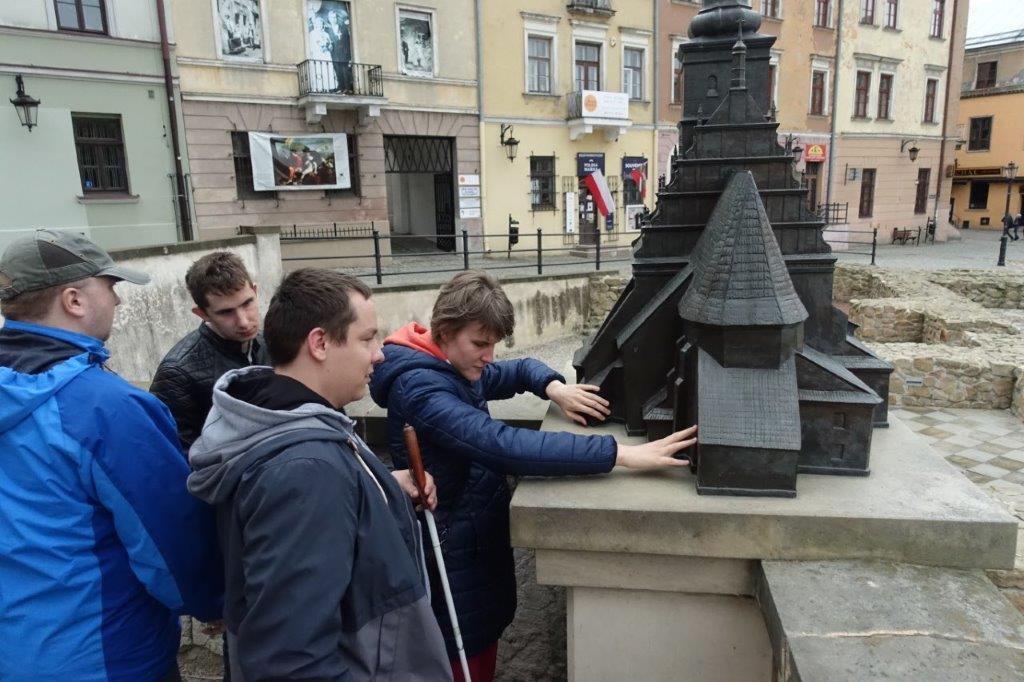
Three lines drawn on a sheet of paper. Two horizontal, one vertical. The first is a platform to which you must climb. The vertical one is a handrail that you must hold. The second horizontal line is a seat on which you must sit not to fall over. Together they make ... the bus. This is how a child blind from birth, who has no memory of any images, shapes, colours, because they have NEVER seen them, imagines it. This drawing still deeply touches prof. Bogusław Marek, who devoted his scientific activity to the blind and visually impaired.
There is still another drawing which moves me. It was made by a 16-year-old girl, also blind from birth – a kind of circle with a zigzag in the middle, and a lot of lines scattered around. It turned out that they were arms, legs and hair, completely disconnected from each other. The girl had no idea how to merge them together, what a man looks like...
And these are just the first steps, in a foreign world made for those who were lucky enough to be born with healthy eyes.
I can only associate colours with items or ideas. I associate black with sadness, but also with elegance, e.g. an elegant dress. I know the sea is blue, but the tones are completely abstract to me…
– says Ms. Izabela, who is blind from birth. She comes from Warsaw but is studying in Lublin. Luckily, from childhood, she could enjoy a good education for the blind. However, contact with art: museums, galleries, architecture is still a major problem.
Generally, this is not very well organized. In museums, it is forbidden to touch the exhibits. Sometimes during visits for the blind we could touch something, but it required a special permit from the institution and only thanks to our teachers we were able to obtain them. The only place where I came across the exhibits prepared for us was the Museum of the History of the City of Lublin.
This is an institution with which prof. Bogusław Marek – initiator and coordinator of the TouchingThePast project – had cooperated before. Mr. Marek specializes in teaching English to the blind, he is the Plenipotentiary of the Rector of the John Paul II Catholic University of Lublin (KUL) for Students with Disabilities and at the same time Director of the University Centre for the Activation of People with Disabilities. He shared his experiences, among others in India, Nepal and Japan. His work was appreciated even by the Queen Elizabeth II, from whom he received the Order of the British Empire. His project implemented within the PL-BY-UA Programme will allow him to share his extensive knowledge and experience with neighbours from across the eastern border.
I chose Ivanofrankivsk in Ukraine because it lies quite close. I also checked on the website what monuments were there and that's how it all started...
The invitation for cooperation sent by the KUL was accepted by the Vasyl Stefanyk Precarpathian National University in Ukraine. At the beginning, the partners had to answer the question: how to bring art and monuments to the blind – not only tactile sculptures, but also flat two-dimensional paintings, small jewellery, coins or high architecture?
Even the very notion of perspective without explanation was an abstraction for me…
– says Ms. Izabela who hopes that the venture will help people like her. Therefore, the authors of the project decided to adapt selected exhibits and historic objects to the needs of people with visual impairments. Only in the Lubelskie Voivodeship there are about 4,000 such people. As part of the project, i.a. three-dimensional models of buildings, tactile graphics and so-called "talking" images and diagrams will be prepared.
Special software makes that a person pressing a selected part of a drawing hears a verbal comment on that…
– explains prof. Marek. Audio-descriptive texts and special Braille guides will also be prepared. Tourist guides and museum staff in both cities will be trained to guide the blind and visually impaired people. The disabled will also undergo training to help them perceive art. Finally, they will have an opportunity to test the tourist offer prepared for them, and the closing conference will sum up all activities provided within the project.
The project authors hope that the partnership established within the project between Lublin and Ivanofrankivsk will give rise to many further activities. A good example of selected museums will encourage other museums, art galleries and cultural centres to prepare for the reception of people with disabilities, especially the blind and visually impaired.
However, for all this to come true, in a joint project they first had to draw the first three lines...
Was this page useful?


